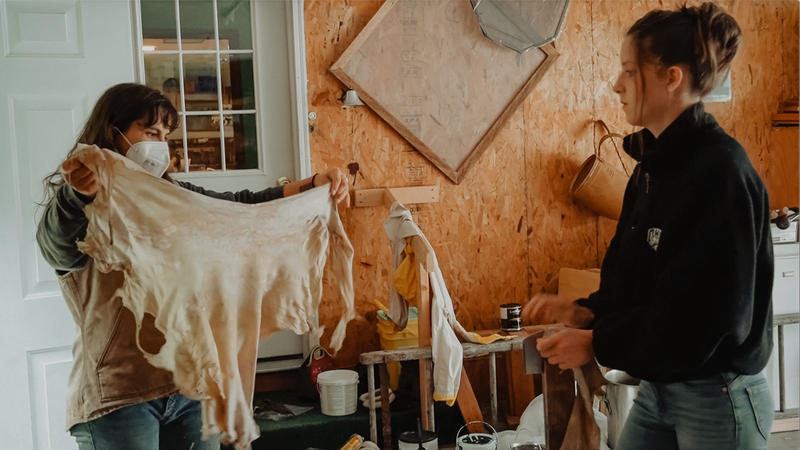
In a quiet neighborhood in southeast Ohio, Talcon Quinn and her 12-year-old apprentice Juniper Ballew have revived an age-old tradition with just three ingredients: a deer skin, some water and a handful of animal brains. They have transformed a hairy, fleshy animal skin into buckskin, a buttery soft material stronger than fabric.
West Virginia Public Broadcasting
Clara Haizlett
July 23, 2020
In a quiet neighborhood in southeast Ohio, Talcon Quinn and her 12-year-old apprentice Juniper Ballew have revived an age-old tradition with just three ingredients: a deer skin, some water and a handful of animal brains. They have transformed a hairy, fleshy animal skin into buckskin, a buttery soft material stronger than fabric.
In a special report as part of the Inside Appalachia Folkways Project, reporter Clara Haizlett met with Quinn and Ballew to find out why they practice the tradition of brain tanning.
Quinn has trained Ballew in the art of brain tanning, through an apprenticeship program with the Ohio Arts Council. While most modern tanneries use chemicals to tan, Quinn and Ballew use the traditional method of soaking the hide in animal brains.
Brain tanning requires a strong back and a stronger stomach, patience and some serious elbow grease. To tan one hide it takes around 16 hours of intense labor extended over multiple days.
Quinn’s workshop is located out of her garage at home, which is in a quiet neighborhood on the outskirts of Athens, Ohio.
Holding a deer skin, Quinn instructed her apprentice to “find the neck, find the membrane side, and what I’d like you to do is go down the spine, and put your weight into the cable.”
Quinn coached her apprentice through a step called cabling, a technique for softening the hide. At this stage in the process, the deer skin was slippery and limp, resembling a slimy blanket. Following Quinn’s lead, Ballew leaned back and pulled at the hide, abraiding it against a wire cable. Back and forth she yanked at the deer skin, one foot in front of the other.
Both Quinn and Ballew are from southeast Ohio, a cradle of forests, rivers, lakes and the foothills of the Appalachian Mountains. Growing up in the region, Quinn spent a lot of time outdoors, developing a deep appreciation for her natural environment. In her early twenties she began providing more of her own food by fishing, hunting and picking up roadkill.
Prior to adoption of these practices, Quinn was a vegetarian, then a vegan. Yet in spite of this shift in lifestyle, she continued to set high ethical standards for herself. Quinn decided that if she was going to source her own meat, she wanted to be respectful and use all of the animal. That is what led her to brain tanning.
“I think because I’ve always been a craftsperson and not easily squeamish, I just took to it really easily and fell in love with it in ways,” Quinn said.
Read the full article at wvpublic.org.

